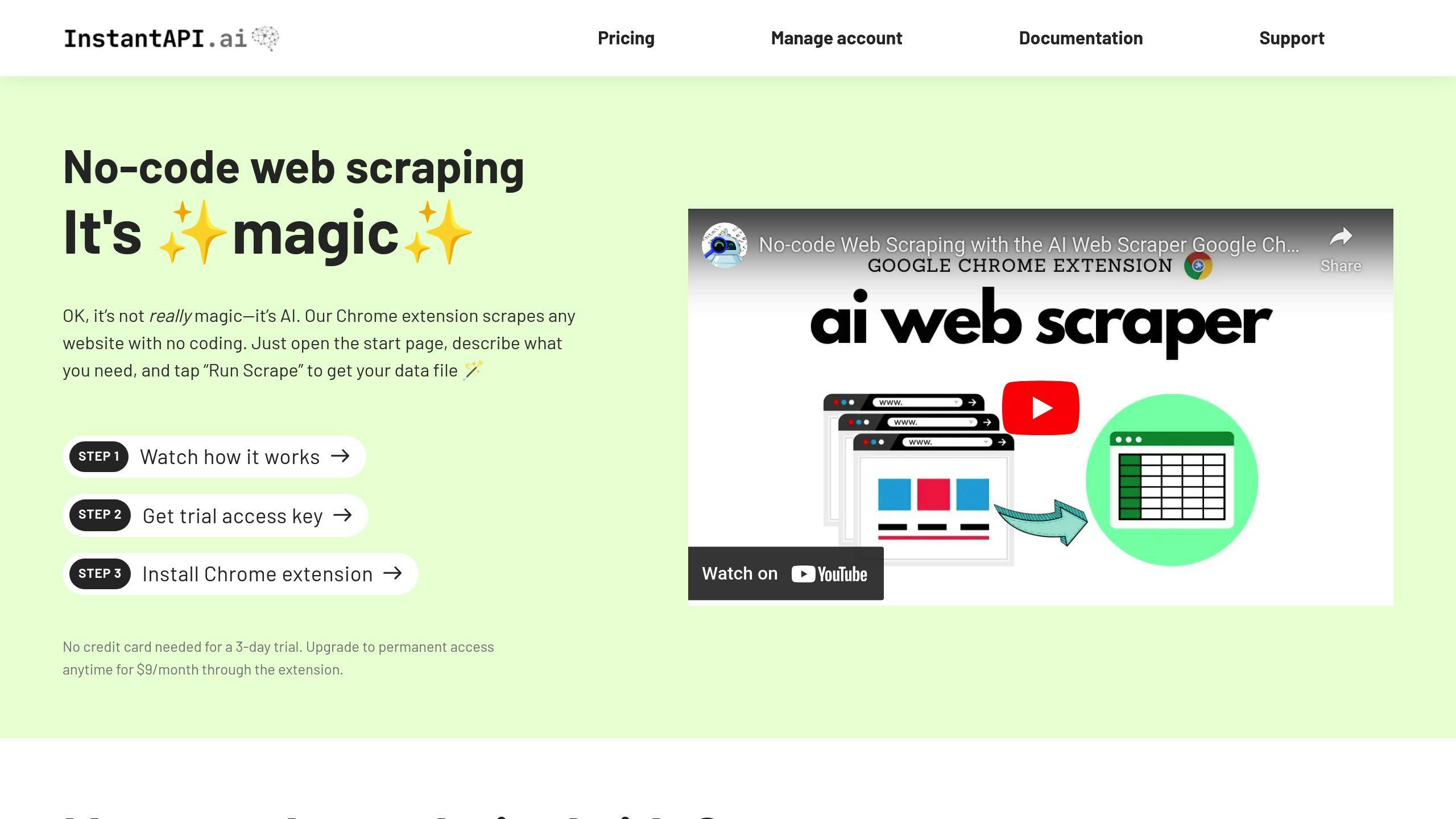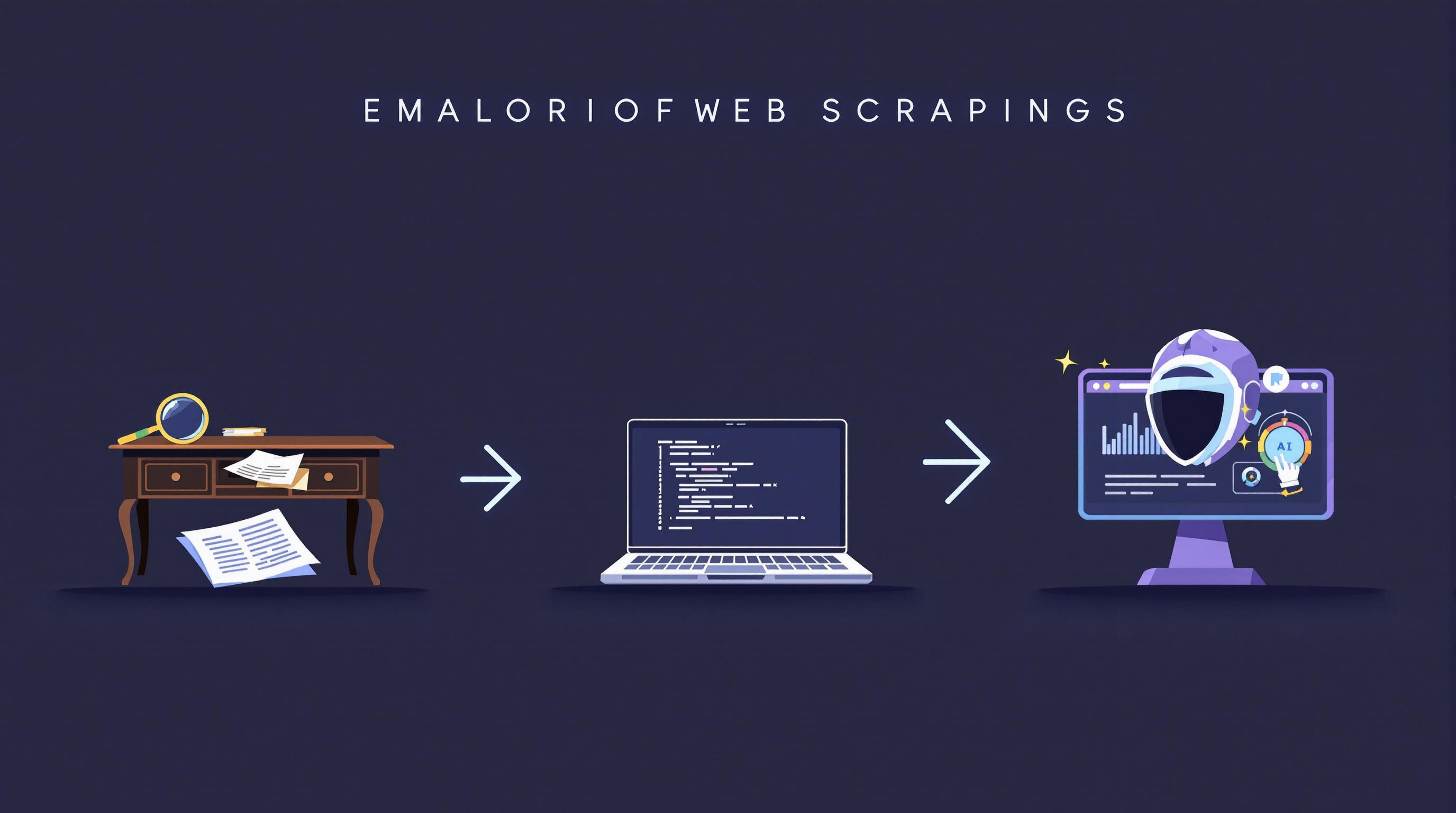Reinforcement learning (RL) is reshaping web scraping by making it smarter, faster, and more adaptable to challenges like dynamic content and anti-scraping defenses. Unlike traditional scrapers, RL systems learn from experience, improving accuracy and reducing manual maintenance over time.
Key advantages of RL in web scraping include:
- Automatic Adaptation: Handles website changes and dynamic content seamlessly.
- Anti-Scraping Solutions: Learns to bypass CAPTCHAs, IP blocks, and rate limits effectively.
- Reduced Maintenance: Self-learning systems minimize manual updates.
- Improved Accuracy: Achieves up to 95% precision in data extraction, even on complex sites.
Quick Comparison of Web Scraping Methods
| Aspect | Traditional Scraping | RL-Powered Scraping |
|---|---|---|
| Handling Dynamic Content | Struggles with JavaScript | Learns and adapts automatically |
| Anti-Scraping Measures | Easily blocked | Adjusts patterns to avoid detection |
| Maintenance Effort | High | Minimal |
| Scaling Capability | Limited | Flexible and efficient |
Tools like InstantAPI.ai demonstrate how RL can automate and refine web scraping, offering no-code solutions, JavaScript support, and enterprise-level scalability. Industries like e-commerce and finance are already seeing significant benefits, such as reduced blocked requests and improved data accuracy.
Reinforcement learning is not just the future of web scraping - it’s solving today’s toughest challenges.
Mechanics of Reinforcement Learning in Web Scraping
Principles of Reinforcement Learning in Web Scraping
Reinforcement learning (RL) in web scraping combines several components to create a system capable of intelligent data extraction. These components include:
- State Space: Represents the structure and layout of websites.
- Action Space: Defines possible interactions, such as navigating pages or extracting data.
- Reward Function: Provides feedback based on the success of data extraction or the quality of the data.
- Policy: Determines the agent's actions using algorithms like Q-learning or SARSA.
The RL agent interacts with websites by observing their current state, selecting actions, and receiving feedback through the reward function. For instance, when scraping product details from an e-commerce site, the agent learns to identify the best paths for data collection. Positive rewards are given for successful extractions, while penalties are applied for errors or missed information. This approach allows RL agents to handle complex, ever-changing web environments effectively.
Handling Dynamic and Anti-Scraping Environments
Dynamic websites and their protective measures present unique challenges for web scraping. RL agents handle these by learning to recognize patterns, adapt to changing DOM structures, and identify stable states for consistent data extraction.
To bypass anti-scraping mechanisms, RL systems adjust request patterns, rotate IP addresses, and time their actions to avoid detection. When faced with CAPTCHAs, they can pause or reroute to ensure uninterrupted scraping.
Through iterative learning, these agents refine their strategies to maintain reliable data extraction while respecting website resources and terms of service. This approach allows RL-driven systems to overcome the limitations of traditional scraping techniques, providing a more flexible and effective solution.
Advantages of Reinforcement Learning in Web Scraping
Accuracy in Data Extraction
Reinforcement learning (RL) improves the precision of web scraping by using a reward system to fine-tune extraction strategies. This approach helps maintain high data quality, even when websites change their DOM structure or add new elements. RL agents adjust their methods based on previous successes, reducing the need for manual updates and keeping data extraction consistent.
Reduced Manual Effort
RL-powered web scraping drastically cuts down on maintenance. Unlike traditional methods, which demand constant oversight, RL systems adjust automatically. This means developers spend less time updating rules, fixing scrapers, handling anti-scraping measures, or responding to layout changes.
Handling Complex Scraping Tasks
RL brings smarter decision-making to large-scale scraping, improving efficiency and resource use. Here's how it compares to traditional methods:
| Aspect | Traditional Methods | RL Methods |
|---|---|---|
| Resource Allocation | Fixed and predefined | Dynamic and flexible |
| Task Prioritization | Requires manual input | Automatically optimized |
| Error Handling | Needs manual fixes | Self-adjusting |
| Scaling Capability | Limited by rigid rules | Adapts to complexity |
These benefits shine in challenging scenarios like:
- Handling dynamic content
- Navigating complex site structures
- Extracting large datasets
- Overcoming anti-bot defenses
Python AI Web Scraper Tutorial - Use AI To Scrape ANYTHING
sbb-itb-f2fbbd7
Tools and Frameworks for Reinforcement Learning in Web Scraping
Reinforcement learning is making waves in web scraping, offering practical solutions that turn complex theories into actionable tools.
InstantAPI.ai

InstantAPI.ai uses reinforcement learning to automate and refine web scraping tasks. Its AI engine improves with every interaction, adapting to changes in websites and overcoming anti-scraping measures while maintaining accuracy.
Some standout features include:
- AI-driven data extraction without needing xPath setup
- Automatic adjustments to website updates
- Enterprise-level infrastructure that supports unlimited concurrent requests
- Seamless handling of JavaScript-rendered and dynamic sites
- A robust proxy network for consistent access
Comparison of Tool Features
Here's how InstantAPI.ai stacks up against other popular tools like Scrapy and ParseHub:
| Feature | InstantAPI.ai | Scrapy | ParseHub |
|---|---|---|---|
| AI Adaptation | Continuous self-learning | Manual updates required | Semi-automatic |
| Content Processing | Full JavaScript support | Limited rendering | Full support |
| Infrastructure | Premium proxies, unlimited scaling | Basic proxy support | Plan-based limits |
| Implementation | No-code solution | Advanced coding required | Moderate setup |
| Website Handling | Automatic response to changes | Manual configuration needed | Semi-automatic |
Your choice of tool will depend on factors like:
- The scale of your project
- Your technical skills
- Budget considerations
- Complexity of target websites
- Level of automation required
These tools are constantly improving, addressing new challenges in web scraping. They showcase how reinforcement learning bridges the gap between theory and practical applications, paving the way for the next steps in this field.
Examples and Case Studies
Here’s how tools like InstantAPI.ai and reinforcement learning are reshaping web scraping across different industries.
Case Studies of Reinforcement Learning
An e-commerce data analytics company boosted product data extraction accuracy from 75% to 90% on dynamic websites by using reinforcement learning algorithms. A financial data aggregator cut scraping time by 70% while maintaining 95% accuracy, even on JavaScript-heavy sites. Meanwhile, a university research team reduced blocked requests by 85% by mimicking human browsing behavior.
Key Insights and Applications
Practical implementations have uncovered some key strategies for success:
| Challenge | Solution | Impact |
|---|---|---|
| Frequent Website Changes | Learning Algorithms | Reduced maintenance requirements |
| Anti-Scraping Mechanisms | Human Behavior Simulation | 85% fewer blocked requests |
| Complex Data Structures | Hierarchical RL Techniques | 95% accuracy in data extraction |
These successful approaches tend to share a few common traits:
- Clear Optimization Goals: Systems define reward metrics and balance exploring new patterns with leveraging proven methods.
- Data-Focused Learning: Initial training data paired with ongoing feedback loops ensures consistent performance.
- Flexibility: High accuracy is maintained even when websites undergo major changes.
In the financial industry, reinforcement learning has been particularly effective for multi-step data extraction. These systems consistently deliver 95% accuracy on structured data, handle dynamic content seamlessly, and require minimal manual adjustments.
These examples show how reinforcement learning is driving major advancements in web scraping, opening the door for even more progress.
Conclusion
Main Points
Reinforcement learning (RL) is transforming web scraping by bringing smarter and more efficient data extraction to the table. With its ability to learn and optimize automatically, RL-powered systems have tackled tough scraping challenges with impressive results. For example, industries like finance and e-commerce have reported 95% data accuracy, better handling of dynamic content, and an 85% drop in blocked requests.
RL's impact on improving accuracy, cutting down blocked requests, and boosting efficiency is undeniable. As the technology advances, it’s set to take on even more complex web scraping tasks.
Future of Reinforcement Learning in Web Scraping
The future of reinforcement learning in web scraping looks promising, with advancements expected in several areas.
| Focus Area | Impact |
|---|---|
| Algorithm Sophistication | Better handling of dynamic content |
| AI Integration | Smarter pattern recognition and adaptation |
| Automated Optimization | Less reliance on manual setup |
Smarter algorithms will make dynamic content easier to manage, while deeper AI integration will sharpen pattern recognition. Combining RL with techniques like deep learning will lead to more robust and adaptable scraping systems. As web technologies progress, these innovations will ensure seamless and reliable data extraction.
Platforms like InstantAPI.ai highlight how RL is simplifying and improving web scraping. With ongoing advancements, RL is set to play an even bigger role in delivering accurate, efficient, and automated solutions for modern web scraping needs.


